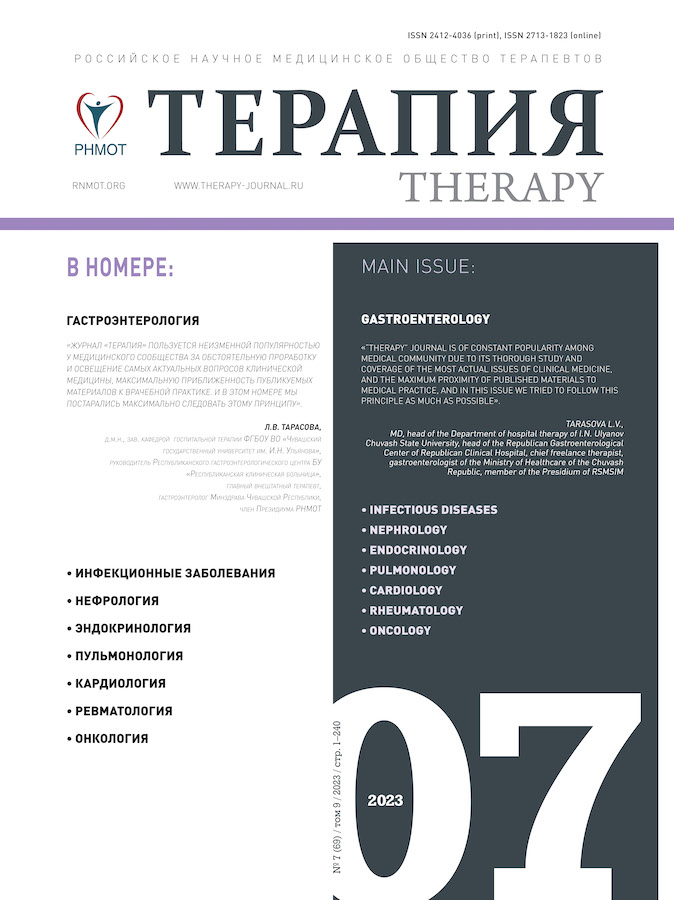Impact of long-term antiarrhythmic therapy on the progression of atrial fibrillation from paroxysmal to permanent form
- Authors: Tarzimanova A.I.1
-
Affiliations:
- I.M. Sechenov First Moscow State Medical University of the Ministry of Healthcare of Russia (Sechenov University)
- Issue: Vol 9, No 7 (2023)
- Pages: 208-213
- Section: ACTUAL ISSUES OF PHARMACOTHERAPY AND PREVENTIVE TREATMENT
- URL: https://journals.eco-vector.com/2412-4036/article/view/625444
- DOI: https://doi.org/10.18565/therapy.2023.7.208–213
- ID: 625444
Cite item
Abstract
In recent years, it has been proven that there is a certain pattern in the long-term course of atrial fibrillation (AF): from asymptomatic, short episodes of arrhythmia to a stable permanent form of the disease, which creates the prerequisites for the progression of chronic heart failure and significantly worsens the prognosis for patients. The duration of the existence of paroxysmal or persistent form of AF in different patients can vary in a wide range – from several months to decades – and is interconnected with the severity of underlying disease. Paroxysmal AF persists for many years in only a small part of patients. Slowing the progression of AF from paroxysmal to permanent form improves the prognosis of patients, therefore, the assessment of risk factors for the progression of arrhythmia and prescription the correct tactics for managing patients are urgent tasks of modern cardiology.
Full Text
About the authors
Aida I. Tarzimanova
I.M. Sechenov First Moscow State Medical University of the Ministry of Healthcare of Russia (Sechenov University)
Author for correspondence.
Email: tarzimanova@mail.ru
ORCID iD: 0000-0001-9536-8307
MD, professor of the Department of faculty therapy No. 2
Russian Federation, 119048, Moscow, 24 Efremova Str.References
- Hindricks G., Potpara T., Dagres N. et al. 2020 ESC Guidelines for the diagnosis and management of atrial fibrillation developed in collaboration with the European Association for Cardio-Thoracic Surgery (EACTS): The Task Force for the diagnosis and management of atrial fibrillation of the European Society of Cardiology (ESC) Developed with the special contribution of the European Heart Rhythm Association (EHRA) of the ESC. Eur Heart J. 2021; 42(5): 373–498. https://dx.doi.org/10.1093/eurheartj/ehaa612.
- Charitos E.I., Purerfellner H., Glotzer T.V., Ziegler P.D. Clinical classifications of atrial fibrillation poorly reflect its temporal persistence: Insights from 1,195 patients continuously monitored with implantable devices. J Am Coll Cardiol. 2014; 63(25 Pt A): 2840–48. https://dx.doi.org/10.1016/j.jacc.2014.04.019.
- de Vos C.B., Pisters R., Nieuwlaat R. et al. Progression from paroxysmal to persistent atrial fibrillation clinical correlates and prognosis. J Am Coll Cardiol. 2010; 55(8): 725–31. https://dx.doi.org/10.1016/j.jacc.2009.11.040.
- De Vos C.B., Breithardt G., Camm A.J. et al. Progression of atrial fibrillation in the REgistry on Cardiac rhythm disORDers assessing the control of Atrial Fibrillation cohort: Clinical correlates and the effect of rhythm-control therapy. Am Heart J. 2012; 163(5): 887–93. https://dx.doi.org/10.1016/j.ahj.2012.02.015.
- Heijman J., Voigt N., Nattel S., Dobrev D. Cellular and molecular electrophysiology of atrial fibrillation initiation, maintenance, and progression. Circ Res. 2014; 114(9): 1483–99. https://dx.doi.org/1010.1161/CIRCRESAHA.114.302226.
- Veasey R.A., Sugihara C., Sandhu K. et al. The natural history of atrial fibrillation in patients with permanent pacemakers: Is atrial fibrillation a progressive disease? J Interv Card Electrophysiol. 2015; 44(1): 23–30. https://dx.doi.org/10.1007/s10840-015-0029-x.
- Im S.I., Chun K.J., Park S.J. et al. Long-term prognosis of paroxysmal atrial fibrillation and predictors for progression to persistent or chronic atrial fibrillation in the Korean population. J Korean Med Sci. 2015; 30(7): 895–902. https://dx.doi.org/10.3346/jkms.2015.30.7.895.
- Nieuwlaat R., Capucci A., Camm A.J. et al. Atrial fibrillation management: A prospective survey in ESC member countries: The Euro Heart Survey on Atrial Fibrillation. Eur Heart J. 2005; 26(22): 2422–34. https://dx.doi.org/10.1093/eurheartj/ehi505.
- Holmqvist F., Kim S., Steinberg B.A. et al.; ORBIT-AF Investigators. Heart rate is associated with progression of atrial fibrillation, independent of rhythm. Heart. 2015; 101(11): 894–99. https://dx.doi.org/10.1136/heartjnl-2014-307043.
- Lafuente-Lafuente C., Longas-Tejero M.A., Bergmann J.F., Belmin J. Antiarrhythmics for maintaining sinus rhythm after cardioversion of atrial fibrillation. Cochrane Database Syst Rev. 2012; (5): CD005049. https://dx.doi.org/10.1002/14651858.CD005049.pub3.
- Kirchhof P., Lip G.Y., Van Geider I.C. et al. Comprehensive risk reduction in patients with atrial fibrillation: Emerging diagnostic and therapeutic options – a report from the 3rd Atrial Fibrillation Competence NETwork/European Heart Rhythm Association consensus conference. Europace. 2012; 14(1): 8–27. https://dx.doi.org/10.1093/europace/eur241.
- Kirchhof P., Camm A.J., Goette A. et al. Early rhythm-control therapy in patients with atrial fibrillation. N Engl J Med. 2020; 383(14): 1305–16. https://dx.doi.org/10.1056/NEJMoa2019422.
- Миллер О.Н., Старичков С.А., Поздняков Ю.М. с соавт. Эффективность и безопасность применения пропафенона (Пропанорма®) и амиодарона (Кордарона®) у больных с фибрилляцией предсердий на фоне артериальной гипертонии, ишемической болезни сердца и хронической сердечной недостаточности с сохраненной систолической функцией левого желудочка. Российский кардиологический журнал. 2010; 15(4): 55–71. [Miller O.N., Starichkov S.A., Pozdnyakov Yu.M. et al. Effectiveness and safety of propafenone (Propanorm®) and amiodarone (Cordarone®) in patients with atrial fibrillation, arterial hypertension, coronary heart disease, and chronic heart failure with intact left ventricular systolic function. Rossiyskiy kardiologicheskiy zhurnal = Russian Journal of Cardiology. 2010; 15(4): 55–71 (In Russ.)]. EDN: MUENJV.
- Stoschitzky K., Stoschitzky G., Lercher P. et al. Propafenone shows class Ic and class II antiarrhythmic effects. Europace. 2016; 18(4): 568–71. https://dx.doi.org/10.1093/europace/euv195.
- Подзолков В.И., Тарзиманова А.И. Антиаритмическая терапия в лечении фибрилляции предсердий: вчера, сегодня, завтра. Кардиоваскулярная терапия и профилактика. 2019; 18(3): 81–87. [Podzolkov V.I., Tarzimanova A.I. Antiarrhythmic therapy in the treatment of atrial fibrillation: Yesterday, today, tomorrow. Kardiovaskulyarnaya terapiya i profilaktika = Cardiovascular Therapy and Prevention. 2019; 18(3): 81–87 (In Russ.)]. https://dx.doi.org/10.15829/1728-8800-2019-3-81-87. EDN: LYKEFP.
Supplementary files








